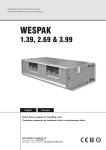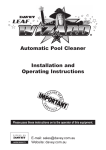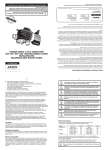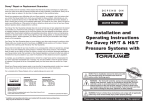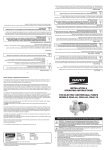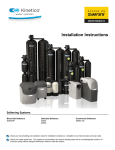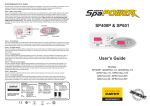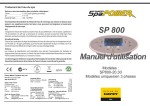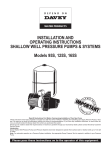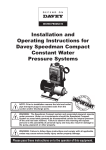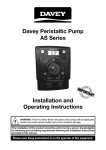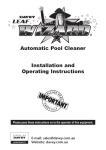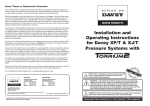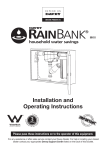Download InStallatIon and oPeratIng InStructIonS
Transcript
VM Series Stainless Steel Vertical Multistage Pumps Installation and Operating Instructions In accordance with AS/NZS 60335.2.41 we are obliged to inform you that this pump is not to be used by children or infirm persons and must not be used as a toy by children. These Instructions must be delivered with the pump to the operator. WARNING: Failure to follow these instructions and comply with all applicable codes may cause serious bodily injury and/or property damage. General Safety Specifications Symbols used in the manual Applications Pumps for clear liquids, free of abrasives in residential, agricultural, industrial, and other applications. Operating Conditions • Temperate range: • Ambient temperature: • Suction head: Read this data sheet carefully before installing and starting your pump. Pay special attention to the points concerning the safety of the equipment. WARNING -15 to +120°C up to 40°C depends on NPSH of pump Instructions concerning electricity Maximum Inlet Pressure The maximum inlet pressure is shown in the list below. But the actual inlet pressure plus the valve close pressure of the pump shall be lower than the maximum allowable working pressure. Model VM3-8 & above Up to VM5-10 VM5-12 & above Up to VM10-6 VM10-8 & above VM16-2 and VM16-3 VM16-4 & above VM32-2A to VM32-4 VM32-6 to VM32-10 VM32-12 VM65-2A VM65-2 to VM65-3 VM65-4A and VM65-5 Up to VM90-3A VM90-3 & above Calls attention to a potential risk that might affect safety. Max. Inlet Pressure 10 bar 10 bar 15 bar 6 bar 10 bar 6 bar 10 bar 4 bar 10 bar 15 bar 4 bar 10 bar 15 bar 10 bar 15 bar Maximum Working Pressure Model Up to VM3-15 VM3-17 & above Up to VM5-16 VM5-19 and VM5-22 VM10-12 VM10-14 & above Up to VM16-8 VM16-11 & VM16-14 Up to VM32-6 VM32-8 & above VM65 range VM90 range Transport and Storage When taking delivery of the pump, check that it has not been damaged in transit. If anything is found wrong, take the necessary steps with the carrier within the allowed time. If the equipment delivered is to be installed at a later time, store it in a dry place and protect it from impact and outside hazards (moisture, frost, etc.). Handle the pump carefully so as not to alter the geometry or alignment of the hydraulic assembly. Product Description The pump Multistage vertical pump (2 to 20 stages, depending on model). Not self-priming. Ports in line at bottom. Shaft sealing by standardized mechanical seal. • Flanges* Flanges are round for all models and include screwed companion flanges with gaskets, nuts, bolts and washers. Curve Number 1 2 1 2 1 3 1 3 1 4 1 1 * Remove protective inserts from pump ports before fixing flanges to pump. The motor The Davey VM series multi-stage pumps have been specifically designed to be used with special TEFC flange mounted electric motors. Typical specification for motors supplied are; • TEFC motor with standard metric frame flange and shaft for vertical operation. Motor and pump linked by a coupling with safety guards. • Protection index: • Insulation class: The following figure shows the limitation of pressure and temperature, which shall be kept within the region as shown in the figure. P(bar) 28 24 20 16 12 8 4 0 • Single phase motors up to 2.2kW include built-in thermal protection with automatic reset, except special dual voltage (240/480v) motors. • Dual voltage / larger single phase motors and three phase motors to be wired in with a contactor incorporating quick-trip thermal overloads. 4 3 2 1 -40 0 40 80 IP 54 (min.) F NOTE: • Motor sizes 0.37kW to 4.0kW are V18 / B14 small flange mounted. • Motor sizes 5.5kW to 22kW are V1 / B5 large flange mounted, with special bearings. 120 t(oC) 2 FREQUENCY SPEED VOLTAGE* 1-PHASE 3-PHASE <4kW 3-PHASE 4kW & above * Standard voltage; tolerance ± 10% 50Hz 2900 rpm 230V 230-400V 400V Two standard cases for pump installations: 1. Pump in suction lift situation. 2. Pump installed with positive inlet. Motor specifications are typical and should be confirmed at time of order. Assembly for pumps supplied without motors fitted Some Davey VM series multistage pumps require special size motor bearings built into the motor which may not allow the use of standard flange mounted motors. Suction Lift: Pumps operate more efficiently with positive suction. If the pump must be installed with a suction lift, please ensure the suction line is kept as short as possible and the pipe diameter is at least on size or larger than the pump inlet. Suction line should be continuously rising from the water source to the pump in order to avoid vapour locks. To assemble the motor onto the pump, ensure that the motor dimensions match the pump head dimensions. For suction lift greater than 3 metres or suction distance greater than 50m please contact Davey. Ensure the motor mounting face and shaft are clean and free of debris. Lower the motor onto motor adaptor and secure with four setscrews into the motor flange. Attach the coupling halves onto the motor shaft and wet end shaft locating the coupling onto the pump shaft pin. Secure the coupling with four screws. Hand tighten only on the motor end and somewhat tighter on the pump end to clamp the pump shaft. Ensure the pump shaft and coupling will move as one up and down on the motor shaft. Push coupling down as far as possible and note it’s position. Raise the coupling up as far as possible and mark this position. Set the coupling at the midpoint between the top and bottom positions. Tighten all four coupling screws evenly (tighten M6 coupling screws to 14Nm or M10 coupling screws to 36Nm). Rotate the shaft and ensure it is free and not rubbing. Run the pump for a short period and recheck the pump still is free to rotate without interference. Positive Inlet: Recommended installation for efficient pumping. Pumping direct from town water supply must be in compliance with local regulations. Install the pump in a place that is easy to reach, protected from frost, and as close as possible to the place from which water is drawn. Install the pump on a foundation block at least 100mm high and attach via the holes for 12mm dia. studs. For heavy pumps, provide a point of attachment above the pump centre line. Place an insulating material (cork or reinforced rubber) under the concrete block to avoid transmitting noise and vibrations to the rest of the installation. Before final tightening of the anchor bolts, make sure that the pump centreline is quite vertical; use shims if necessary. NOTE: Disconnect pump from power before undertaking ANY servicing or clearance checks on the pump. The altitude of the installation and the water temperature reduce the suction capabilities of the pump. Installation Housing your Pump To protect your pump from the weather, make sure the cover provided is both water proof, frost free and has adequate ventilation. The pump should be vertically mounted on a firm dry base allowing for drainage, to avoid damage to flooring. Altitude & Temperature vs Loss of Head Altitude Loss of head 0m 0m 500m 0.60m 1000m 1.15m 1500m 1.70m 2000m 2.20m 2500m 2.65m 3000m 3.20m Temperature 20°C 30°C 40°C 50°C 60°C 70°C 80°C 90°C 100°C Loss of head 0.20m 0.40m 0.70m 1.20m 1.90m 3.10m 4.70m 7.10m 10.30m The pump must be placed in a well drained location or in a pan connected to a drain to avoid water damage from leaking fittings, seals etc. Hydraulic connections The diameter of the suction piping must never be less than that of the pump. Limit the length of the suction pipe and avoid all features that cause losses of head (tapers, bends, etc.). The suction pipe, which should slope upward slightly, must be fully airtight, especially at fittings. If a rigid pipe is used, provide supports or collars so that the pump does not bear the weight of the pipe. An arrow on the pump casing shows the direction of fluid flow. Carefully seal the pipes with thread tape. Electrical connections The electrical connections and checks must be made by a qualified electrician and comply with applicable local standards. WARNING: Some insects, such as small ants, find electrical devices attractive for various reasons. If your pump enclosure is susceptible to insect infestation you should implement a suitable pest control plan. continued overleaf... 3 Dry-running protection To avoid accidental loss of prime of the pump, we recommend protecting it with a suitable device. Refer to the motor data plate for its electrical characteristics (frequency, voltage, nominal current). The three-phase and single phase dual voltage motors must be protected by a circuit-breaker or magnetic contactor with overload set to the current marked on the motor data plate. Provide a fused disconnecting or isolating switch, in compliance with local standards. The electric connections should be made as shown in the diagrams inside the cover of the motor terminal box. Check direction of rotation Turn the coupling by hand to make sure that it turns freely, without sticking. Power up the motor by briefly pressing the circuit-breaker and check that it turns in the direction indicated by the arrow on the pump head. DO NOT FORGET TO CONNECT THE EARTH. If not, for three phase, interchange two of the three active wires on the motor terminal block or circuit-breaker. Note that this work must be carried out by a suitably qualified person. A connection error will damage the motor. The power cable must never touch the pipe or the pump; make sure that it is protected from any moisture. For single phase check wiring diagram in terminal box lid. NOTE: Direction of rotation of the motor diagram is when viewed from the motor shaft end. The orientation of the motor can be changed a quarter turn by removing the motor attachment screws (if necessary, remove the coupling guards) and turning the motor to the desired position. Refit the screws and the coupling guards. The standard three phase electric motors used with pumps can be connected to a frequency converter. Strictly follow the directions given by the manufacturer’s data sheet. The converter must not generate a peak change of voltage dV/ dt in excess of 500 V/ms, since this would cause noise and damage the motor winding. If it does, place an LC (inductance-capacitance) filter between the converter and the motor. Starting up The pump must not be operated in a noflow condition (discharge valve closed) for more than 5 minutes with cold water (< 40oC) or more than 2 minutes for hot water. We recommend establishing a minimum flow of about 10% of the rated capacity of the pump, to avoid the formation of a gas pocket at the top of the pump. Open the discharge valve to start the pump. Use a pressure gauge to check the stability of the discharge pressure; if it is unstable, bleed the pump again or repeat the priming operation. Check that the current draw does not exceed the value marked on the motor data plate. Starting Up Filling or Priming Servicing Never operate the pump dry, even briefly. No special servicing is required in normal operation. Always keep the pump perfectly clean, particularly the motor and motor fan cover. Pump in flooded suction installation • Close the discharge valve. • Unscrew the bleed plug fitted to pump head. • Open the suction valve progressively and completely fill the pump. • Screw the bleed plug back in only after water flows out and all air has been eliminated. For a prolonged shutdown, if there is no risk of frost, it is best not to drain the pump. To avoid blocking of the shaft and the hydraulic system, in frosty periods, empty the pump by removing the drain plug and the air bleed plug. • Screw the 2 plugs back in loosely, without tightening them. In a hot-water application, a stream of water may escape from the bleed port. Do what is necessary to protect persons and the motor. Motors without grease fittings The bearings are greased for life and so need no lubrication. Mechanical seal The mechanical seal needs no servicing in operation. It must never be allowed to operate dry. Pump with suction lift • Close the discharge valve. • Open the suction valve if fitted. • Remove the bleed plug on the main body of the pump. • Unscrew the bottom drain and priming plug on the pump casing four or five turns. • Put a funnel into the bleed plug and slowly and completely fill the pump and the suction pipe. • When water flows out and all air has been eliminated, filling is complete. • Screw the bleed plug and the bottom drain and priming plug back in. The following must be done in addition after the filling plug has been screwed back in: • Start the motor briefly. • Unscrew the prime plug again and top up the water in the pump. • If necessary, repeat this operation until all air is expelled from pump. 4 Trouble Shooting Switch the pump OFF before doing any work on it SYMPTOM CAUSE REMEDIES PUMP TURNS BUT NO a) The internal parts are a) DISCHARGE FLOW obstructed by foreign bodies b) Suction pipe obstructed b) c) Air leaks in via suction pipe c) d) The pump has lost its prime d) e) The suction lift is too high, e) this is generally accompanied by cavitation noise f) The pump turns the wrong way f) g) The supply voltage to the g) motor is too low h) No incoming water flow h) (flooded suction) THE PUMP VIBRATES a) Loose on its foundation b) Foreign bodies obstructing the pump c) Pump is hard to turn d) Incorrect electrical connection a) b) c) d) e) The motor fails to run at its normal speed (foreign bodies, defective power supply, etc.) The motor is faulty Pump poorly filled The motor turns the wrong way (three phase only) Suction leak Clean all the pipes. If suction valve fitted, ensure it is fully open. Check the tightness of the suction pipe line, up to the pump, and make it airtight. Fill the pump to re-prime. Check that the foot valve seals and does not leak. Suction height too great (check the NPSH of the pump installed). Install the pump closer to the water. Check direction of rotation in main section. Check the voltage on the terminals of the motor and the crosssections of the conductors. Check water tank or mains for water. a) Check the nuts of the stud bolts and tighten them fully. b) Dismantle the pump and clean it. c) Check that the pump turns freely without abnormal sticking. d) Check the connections to the pump. THE MOTOR OVERHEATS a) Voltage too low: a) b) Foreign bodies obstructing b) the pump c) Ambient temperature above c) +40°C THE PUMP DELIVERS INSUFFICIENT PRESSURE Dismantle the pump and clean it. Check the voltage on the terminals of the motor; it should be within ±10% of the rated voltage. Dismantle the pump and clean it. The motor is designed to operate at an ambient temperature of not more than +40°C. a) Dismantle the pump and correct the problem. b) Replace it. c) Fill the pump and bleed until there are no more air bubbles. d) Alternate two wires on the motor terminal block or the circuit-breaker to reverse the direction of rotation. e) Check and reseal fittings. THE MOTOR TRIPS OUT a) The setting of the thermal a) Check the current with an ammeter, or set to the current rating relay is too low (three-phase marked on the motor data plate. motor) b) The voltage is too low b) Check that the conductor cross-sections of the power cable are adequate. c) One phase is open-circuit c) Check it and correct where required. d) The thermal relay of the circuit- d) Replace it. breaker is faulty e) Ambient temperature above e) The motor is designed to operate at an ambient temperature of +40°C not more than +40°C. THE FLOW IS IRREGULAR a) The suction height is a) exceeded b) The diameter of the suction b) pipe is smaller than that of the pump c) The strainer and suction pipe c) are partially obstructed Reread the installation conditions and recommendations in these instructions. The suction pipe must be sized to suit the application and be at least the same diameter as the pump suction port. 5 Remove and clean. Davey® Repair or Replacement Guarantee In the unlikely event in Australia or New Zealand that this Davey product develops any malfunction within two years of the date of original purchase due to faulty materials or manufacture, Davey will at our option repair or replace it for you free of charge, subject to the conditions below. Should you experience any difficulties with your Davey product, we suggest in the first instance that you contact the Davey Dealer from which you purchased the Davey product. Alternatively you can phone our Customer Service line on 1300 367 866 in Australia, or 0800 654 333 in New Zealand, or send a written letter to Davey at the address listed below. On receipt of your claim, Davey will seek to resolve your difficulties or, if the product is faulty or defective, advise you on how to have your Davey product repaired, obtain a replacement or a refund. Your Davey Two Year Guarantee naturally does not cover normal wear or tear, replacement of product consumables (i.e. mechanical seals, bearings or capacitors), loss or damage resulting from misuse or negligent handling, improper use for which the product was not designed or advertised, failure to properly follow the provided installation and operating instructions, failure to carry out maintenance, corrosive or abrasive water or other liquid, lightning or high voltage spikes, or unauthorized persons attempting repairs. Where applicable, your Davey product must only be connected to the voltage shown on the nameplate. Your Davey Two Year Guarantee does not cover freight or any other costs incurred in making a claim. Please retain your receipt as proof of purchase; you MUST provide evidence of the date of original purchase when claiming under the Davey Two Year Guarantee. Davey shall not be liable for any loss of profits or any consequential, indirect or special loss, damage or injury of any kind whatsoever arising directly or indirectly from Davey products. This limitation does not apply to any liability of Davey for failure to comply with a consumer guarantee applicable to your Davey product under the Australian or New Zealand legislation and does not affect any rights or remedies that may be available to you under the Australian or New Zealand Consumer Legislation. In Australia, you are entitled to a replacement or refund for a major failure and for compensation for any other reasonably foreseeable loss or damage. You are also entitled to have the goods repaired or replaced if the goods fail to be of acceptable quality and the failure does not amount to a major failure. Should your Davey product require repair or service after the guarantee period; contact your nearest Davey Dealer or phone the Davey Customer Service Centre on the number listed below. For a complete list of Davey Dealers visit our website (davey.com.au) or call: AUSTRALIA NEW ZEALAND Customer Service Centre 6 Lakeview Drive, Scoresby, Australia 3179 Ph: 1300 367 866 Fax: 1300 369 119 Website:davey.com.au Customer Service Centre 7 Rockridge Avenue, Penrose, Auckland 1061 Ph: 0800 654 333 Fax: 09 527 7654 Website:daveynz.co.nz Davey Water Products Pty Ltd Member of the GUD Group ABN 18 066 327 517 ® Davey is a registered trade mark of Davey Water Products Pty Ltd. © Davey Water Products Pty Ltd 2011. P/N 400584-5 supersedes P/N 400584-4 * Installation and operating instructions are included with the product when purchased new. They may also be found on our website.







